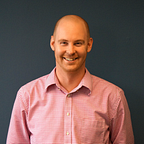Catching Up with Jordan Noeding — Our Senior UX Designer
Sometimes crappy solutions can lead to something great.
Tyler Norton: Tell us a bit about how you got your career started in design.
Jordan Noeding: I graduated with an art degree all bright eyed and bushy tailed. I think I must have sent out resumes to a hundred companies. I heard back from only a handful. None of them were the brilliant design agencies I had envisioned but one did capture my attention. The office consisted of three or four small rooms down a hallway with no windows. I was to be an intern working in one of these windowless rooms with two other people. So what was I thinking saying yes? Well … while we waited for the CEO to show up for my interview for a few hours (he was notorious for this), I got to hang out with the two guys in that small, sad room. I was able to see the excitement around what they were creating and the freedom to create it. I also saw an opportunity to learn something new and have the space to grow.
TN: How did you find your first design job?
JN: Honestly, I don’t really remember exactly. After graduation, the focus was just on getting a foot into the design field. I think it was LinkedIn.
TN: Yes, it was via LinkedIn, you were the only one who submitted a resume with a high quality design portfolio.
The ability to interpret criticism while separating yourself from it is probably the most useful […] thing I’ve learned from design.
TN:What areas do you think your design career has helped you grow in your non-professional life?
JN: So, do you mean my ability to pick out paint colors like a damn professional or my ability to take criticism from my riding instructor without making it personal?
I feel like design is so pervasive, I hardly notice anymore how much I use things like color theory or hierarchy in everyday life. The other day I was choosing pillows and was thinking about contrasting colors and patterns rather than matching. So yeah, design seeps into my existence.
For the non-design-y skills, the ability to interpret criticism while separating yourself from it is probably the most useful. Perhaps you could call it a thicker skin but it takes a lot now for me to get offended if someone tells me they don’t like something I’ve poured hours into.
TN: What company have you always admired and wanted to work for (besides of course RocketReach)?
Ah, the design student in me shouts Pentagram at this question. House Industries in Delaware would also be a fantastic place to work. Dia, Landor, and Pearlfisher also come to mind. Is it strange that I kind of just want to intern at some of these places just to learn?
TN: Not at all! You enjoy your work. It is a good thing. What part of the design process do you enjoy the most? Why does it bring you joy?
JN: The phase where you have the requirements, you’ve done the wireframes and now you get to just create a million ways to do the same thing. I love experimenting, especially without pressure for every solution to be good. It’s that magical time when you can just come up with crappy solutions. Sometimes crappy solutions can lead to something great.
TN: What is the secret to good execution during experiment time? How do you turn crappy into great?
JN: The secret to a good experimental phase? Well … freedom and the ability to go with an idea even if it’s a bad one. Also, the ability to then look at everything at the end of the phase and be able to pick out the good pieces. That’s probably the key, knowing when to stop the bad ideas and start turning them into good ones.
TN: What would you change about your early career decisions and actions knowing what you know now?
JN: I don’t think I’d change much about my early career decisions. I’d change my early designs though.
TN: When reviewing portfolios and resumes of junior designers, what do you look for?
JN: Potential and the ability to talk about the design process and their decisions. I can ignore poor spacing and questionable colors but I am looking for a person who can work through a problem and defend their solutions. That is not to say I can ignore horrible design choices, it is important to show an understanding of the fundamentals.
TN: Lastly, any new design technologies that are exciting to you that you’d like to keep exploring and pushing the limits of?
JN: The implementation of AI into websites has the potential to change the UI game in a way I haven’t seen before. I’m exciting the see how we will be navigating and using the web in the future because of it.
